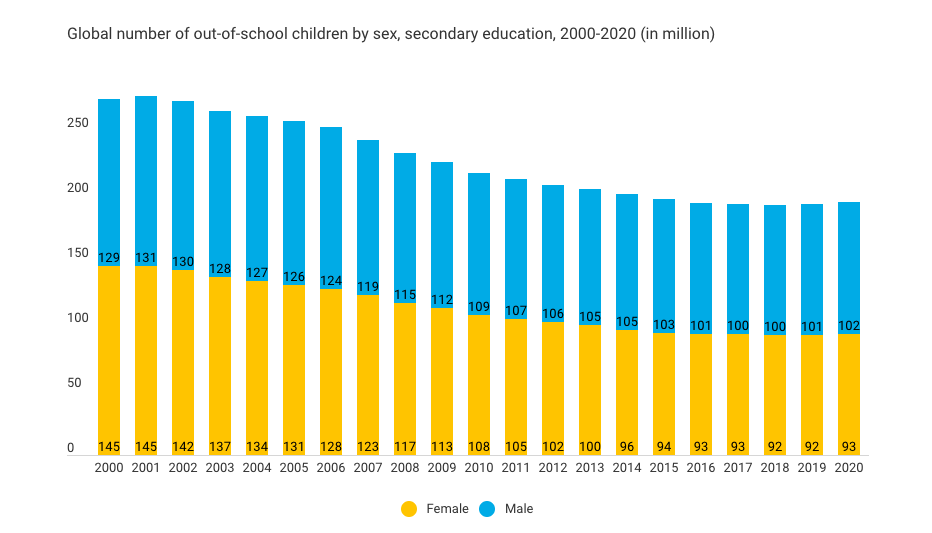Over 129 million women and girls are excluded from education worldwide (UNICEF, 2019).
Education plays a vital role in society. Particularly, access to secondary education creates significant economic growth and development. Investing in education directly affects growth, health, and infrastructure, which contributes to the success of society (The World Bank, 2018). According to the World Bank, education not only promotes human development in areas such as increased health and poverty reduction, but it increases employment, creates innovation, strengthens institutions, instills social cohesion, and drives long-term economic growth (International Bank for Reconstruction and Development, 2011).
The importance of access to secondary education is crucial. If every child had access to secondary education, the child mortality rate for children under five would fall by 49%, individual income would increase by roughly 10% each school year attended, and early pregnancies would decrease by 59% (Cahill, 2019). Additionally, there would be a significant decrease in child labor and gang violence (Buechner & Su, 2022). Most shockingly, according to UNESCO, if all children completed secondary school, the global poverty rate would be cut in HALF (2017). Secondary education not only helps society advance economically, but it also increases the overall health and happiness of a population – which is essential for the prosperity of a people.
So what happens when half (if not more) of that population is left out?
Wouldn’t that mean: half as much growth, development, and prosperity?
Correct.
Women and girls are at the forefront of gender inequality in education.
In 1948 education was declared a human right in article 26 of the United Nations Declaration of Human Rights (International Bank for Reconstruction and Development, 2011). Today, that right is still not guaranteed. Women and girls remain negatively affected by the implementation of laws and policies that prohibit or restrict them from access to education.

Research shows that growth and development flourish when girls have access to secondary education. Access to education for women and girls (Cahill, 2019):
- Reduces child marriage, child/maternal mortality rates
- Allows them to attain higher-earning jobs/become self-sufficient
- Empowers them to make their own choices
- Increases their participation in society
- Creates peaceful social interactions
Restricted access to education forces girls to rely solely on the male population for economic and social security. This results in earlier, increased child marriages and higher birth rates (Delprato, 2022). Educating girls equally reduces gender norms that drive boys to drop out of school to earn an income and support a family. Keeping children in schools reduces child labor and gang violence (Buechner & Su, 2022).
While there has been a movement toward gender equality in secondary education, millions of girls are still not enrolled in formal education (UN Women, 2022).
What is being done?
In 2015, the United Nations created the sustainable development goals (SDGs). These are a call to action by 2030 to have the world enjoy peace and prosperity (United Nations Development Programme, 2023). SDGs 4 and 5 focus on access to quality education and gender equality. These goals aim to ensure inclusive and equitable education for all while achieving gender equality and empowering all women and girls. Major targets of these goals emphasize ending discrimination against women and girls and ensuring all children complete primary and secondary education with effective, quality learning (United Nations, 2022).

While there have been significant increases in access to education, and we are seeing more girls in school now compared to 15 years ago, significant inequalities still exist off-paper (United Nations Development Programme, 2023). In many places where education is “allowed” for girls, they still face gender-based violence on the way to school and within school buildings. In addition, many countries underreport gender parity in their education systems, and when school is in session, how much quality learning is really taking place (Human Rights Watch, 2017)?
If one girl is left behind, significant gaps exist in a nation’s development and, in turn, the world’s development (UN Women, 2022). With advances in education technology (EdTech), education is becoming more easily accessible. The benefits of this must be realized to end this deeply rooted inequality.
Governments worldwide need to take the correct steps to realize the right to equal education. They can create policies to ensure that local governments, communities, and people work together to assist children in the fight for equal, accessible education. With international assistance, governments can build better infrastructure, train teachers, and implement strategies that work to end discrimination (Human Rights Watch, 2017). These issues must be addressed and adjusted for a more productive and peaceful society.
References
Buechner, M., & Su, T. (2022, September 2). 10 Reasons to Educate Girls. Retrieved from UNICEF USA website: https://www.unicefusa.org/stories/10-reasons-educate-girls/40311#:~:text=Girls%20who%20complete%20a%20secondary
Cahill, A. (2019, August 28). The Importance of Secondary Education. Retrieved from The Borgen Project website: https://borgenproject.org/the-importance-of-secondary-education/
Delprato, M. (2022, February 2). Education can break the bonds of child marriage. Retrieved from World Education Blog website: https://world-education-blog.org/2015/11/18/education-can-break-the-bonds-of-child-marriage/
Human Rights Watch. (2017, October 17). “I Won’t Be a Doctor, and One Day You’ll Be Sick” | Girls’ Access to Education in Afghanistan. Retrieved from Human Rights Watch website: https://www.hrw.org/report/2017/10/17/i-wont-be-doctor-and-one-day-youll-be-sick/girls-access-education-afghanistan
International Bank for Reconstruction and Development / The World Bank. (2011). Learning for All. Retrieved from https://openknowledge.worldbank.org/bitstream/handle/10986/27790/649590WP0REPLA00WB0EdStrategy0final.pdf?sequence=1&isAllowed=y
The World Bank. (2018). Overview. Retrieved from World Bank website: https://www.worldbank.org/en/topic/education/overview
UN Women. (2022, October 11). Leaving no girl behind in education. Retrieved from UN Women – Headquarters website: https://www.unwomen.org/en/news-stories/feature-story/2022/10/leaving-no-girl-behind-in-education#:~:text=Worldwide%2C%20nearly%20130%20million%20girls
UNESCO. (2017). Reducing global poverty through universal primary and secondary education. UNESCO Institute for Statistics (UIS). Retrieved from https://uis.unesco.org/en/files/reducing-global-poverty-through-universal-primary-secondary-education-pdf
UNICEF. (2019). Girls’ education. Retrieved from UNICEF for every child website: https://www.unicef.org/education/girls-education
UNICEF. (2022). Secondary Education. UNESCO Institute of Statistics Global Database. Retrieved from https://data.unicef.org/topic/education/secondary-education/
United Nations. (2022). Goal 4 | Department of Economic and Social Affairs. Retrieved from sdgs.un.org website: https://sdgs.un.org/goals/goal4
United Nations Development Programme. (2023). The SDGs in Action. Retrieved from UNDP website: https://www.undp.org/sustainable-development-goals/gender-equality

